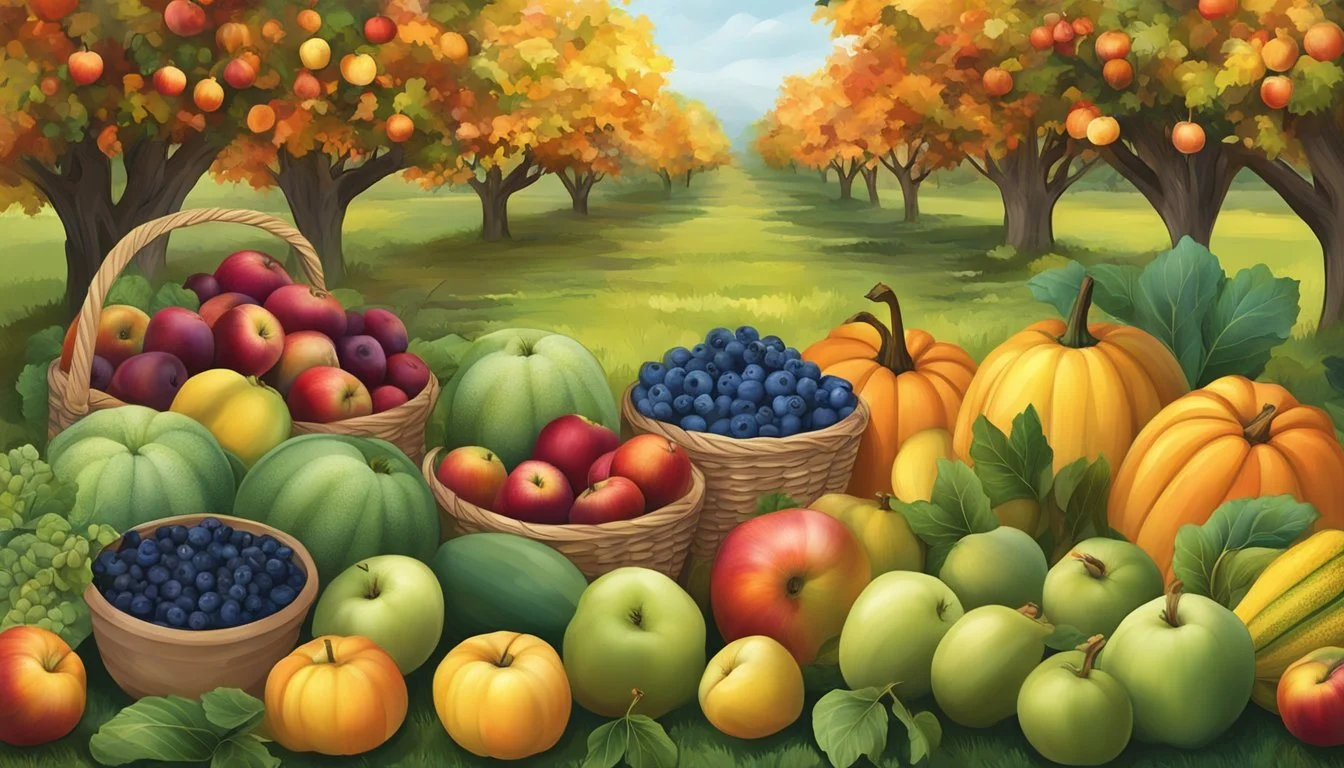Michigan Seasonal Fruit & Vegetables in September
Your Fresh Produce Guide
This Article is Part of our Michigan Seasonal Fruit & Veg Calendar
As September paints Michigan's landscape with the early touch of autumn, the state's orchards, farms, and markets become abundant with a variety of fresh fruits (What wine goes well with fruits?) and vegetables. It's a pivotal month where the last whispers of summer produce meet the hearty, robust flavors of fall's harvest. In this seasonal transition, both consumers and chefs alike find an array of produce to enrich their culinary experiences. Local produce not only boasts freshness but also supports Michigan's agricultural economy, encouraging a sustainable food culture.
The selection of fruits in September is led by late-bearing peaches and plums, which offer a juicy and flavorful farewell to the summer. Apples (how long do apples last?) begin to take center stage, with varieties such as Honeycrisp and Gala becoming ripe for picking, a perfect signal of the coming fall. Vegetables also see a changeover; while summer staples like cucumbers and eggplants (What wine goes well with eggplant?) are still available, the emergence of the second growing season brings a resurgence of leafy greens and broccoli (how long does broccoli last?). Root vegetables, such as beets and carrots, start to peak in flavor and availability, providing a nutritious option for hearty autumnal dishes.
Meanwhile, pumpkins and sweet potatoes mark the onset of the quintessential fall experience. Their versatility in both sweet and savory recipes makes them a favorite during the seasonal shift. These crops are not only significant to the culinary landscape but also serve as cultural hallmarks of Michigan's harvest season, often featured in festivals and community events throughout the state.
Understanding Michigan's Seasonal Produce
Michigan's agricultural richness is reflected in its diversity of fresh produce, particularly as the state transitions from the warm summer months into the cooler fall season. September stands out as a month where this bounty is especially visible, with a variety of fruits and vegetables reaching their peak.
September's Growing Season
In September, Michigan's farmers harvest a wide array of produce. Here are some specific fruits and vegetables that are in season:
Fruits:
Apples
Plums
Grapes
Vegetables:
Broccoli (second growing season)
Leafy greens (second growing season)
Pumpkins
Sweet potatoes
As summer concludes, this period marks the last flourish of certain summer crops, while at the same time, the cooler climate ushers in the first wave of traditional fall produce.
Climate and Regional Influence
The climate in Michigan plays a significant role in shaping its growing seasons. Farmers must stay cognizant of the weather patterns, which can vary greatly across different regions of the state. September weather can fluctuate, keening between the tail end of summer warmth and the onset of crisp fall conditions. This transition influences not only what can be grown, but also where within the state certain crops will thrive. For instance:
Southern Michigan regions may have a longer continuation of summer conditions, which supports the extended growth of summer vegetables.
Northern Michigan, with its generally cooler temperatures, may see an earlier shift to crops that prefer colder weather patterns.
These regional climate differences are vital for consumers to understand, as they greatly impact the availability and quality of the produce throughout different areas of the state.
Key Fruit Varieties Available in September
September in Michigan offers a diverse selection of fruits ripe for the picking. Each variety presents its own unique flavors and culinary possibilities.
Apple Marvels
Michigan's apple harvest thrives in September, presenting an array of varieties. Among these, the Honeycrisp stands out with its crisp texture and well-balanced sweetness, ideal for both eating fresh and baking. Gala apples, with their mildly sweet flavor and firm texture, are also abundant and perfect for snacks and salads.
Honeycrisp: Fresh eating, baking
Gala: Snacking, salads
Stone Fruit Selection
Plums take the spotlight in Michigan's stone fruit harvest during September. With their juicy flesh, plums range from sweet to tart and can be enjoyed fresh, in jams, or baked goods.
Plums: Fresh, jams, baking
Berry Bonanza
While the berry season is winding down, September still offers a chance to enjoy the tail end of the raspberry harvest. This versatile berry adds a vibrant burst of flavor to any dish, whether eaten alone or featured in desserts and preserves.
Raspberries: Fresh, desserts, preserves
Melon Enjoyment
September marks the end of the melon season. Both cantaloupes (how long does cantaloupe last?) and watermelons are available, providing a sweet, hydrating treat. These melons can be enjoyed on their own, in fruit salads, or as a refreshing component to a savory dish.
Cantaloupes: Fresh, fruit salads
Watermelons: Fresh, savory dishes
Key Vegetable Varieties Available in September
Michigan's September harvest offers a bounty of vegetable varieties that are at their peak. From the robust flavors of cruciferous vegetables to the hearty flesh of squashes, the following subcategories showcase the richness of the state's produce.
Cruciferous Choices
Michigan's cooler temperatures in September provide an optimal environment for cruciferous vegetables. Shoppers can find an abundance of:
Broccoli: Cultivated for its dense, green flower heads.
Cauliflower: Sought after for its creamy white curds.
Brussels Sprouts: Characterized by their miniature, cabbage-like appearance.
These vegetables are ideal for roasting or steaming and are packed with nutrients.
Root Vegetable Riches
In the root vegetable department, several varieties make their mark during this month:
Beets: Recognizable by their deep red color and earthy taste.
Carrots: Known for their crunch and sweetness.
Radishes: Offer a peppery bite and are often used in salads.
Harvested just in time for autumn's hearty meal preparations, root vegetables are versatile kitchen staples.
Squash Spectrum
The squash spectrum in Michigan's September harvest includes:
Pumpkins: A symbol of fall and key ingredient in many seasonal dishes.
Sweet Potatoes: With their sweet and creamy texture, they are a favorite for various recipes.
Both of these squash varieties can be baked, roasted, or turned into comforting soups.
Nightshade Necessities
Nightshade vegetables experience a last flourish before the frost:
Tomatoes: Continues to ripen and is perfect for sauces and salads.
Peppers: Ranging from sweet to hot, they add flavor to any dish.
Eggplant: With its unique texture, it's commonly used in hearty entrées.
These are essential for adding depth and richness to recipes.
Leguminous Offerings
Legumes are also part of Michigan's harvest this time of year:
Beans: Varieties include both bush and pole beans, harvested for their tender pods.
Peas: Their sweet pods are enjoyed fresh or can be frozen for later use.
Legumes are an excellent source of protein and can be preserved to enjoy throughout the year.
Harvest Calendar and Availability Guide
In September, Michigan's harvest calendar is rich with a variety of fresh produce. The following is a succinct guide illustrating what consumers can expect to be available at Michigan markets and gardens during this month.
Fruits:
Apples: A staple of Michigan's fall, apples come into season, with varieties like Gala and McIntosh being picked.
Peaches: Late varieties may still be available early in the month.
Plums: Ripe and ready for harvest, they offer a juicy treat.
Vegetables:
Beets: These root vegetables are in their prime, perfect for roasting or pickling.
Broccoli: Available and excellent for both raw and cooked dishes.
Cabbage: Fresh cabbage is ideal for slaws or fermenting into sauerkraut.
Eggplant: They continue to be ripe for picking.
Peppers: From sweet to spicy, peppers are plentiful.
Tomatoes: The warm days keep these garden favorites coming.
Produce availability might vary based on specific regional climates within Michigan, but this guide provides a general window when these items are typically at their peak. Local farmers' markets and farm stands can offer the most current information on what's fresh and in abundance.
For those interested in canning or preserving, September is an opportune time to purchase in bulk and store the bounties of summer. This calendar should serve as a confident and clear route to enjoying Michigan's September harvest.
From Farm to Table: Procuring September Produce
September ushers in a harvest of diverse and nutrient-rich produce in Michigan. Consumers have multiple channels to procure this fresh, local bounty, including farmers markets, grocery stores, and direct farm purchases.
Visiting Local Farmers Markets
Farmers markets are quintessential for finding September-specific produce in Michigan. Shoppers discover an array of fruits and vegetables such as broccoli, leafy greens, plums, and pumpkins that are entering their second growing season. The markets also feature vendors selling September's chestnuts. Enthusiasts suggest arriving early for the best selection and engaging with growers to learn about the produce and farming practices.
What to Look for in a Grocery Store
Grocery stores with local produce sections can be an alternative for the freshest seasonal food. In September, consumers should look for signs that indicate Michigan-grown produce to ensure they're buying local. Grocery stores often supply a similar range as farmers markets including broccoli, plums, and vibrant green vegetables. Checking the product origin or asking store staff can lead to informed purchases of peak-season freshness.
Direct From Farm Purchases
Buying directly from farms can provide the freshest and most direct connection to September's harvest. Many farms offer the chance to buy produce like pumpkins and sweet potatoes right where they are grown. Shoppers may find opportunities for pick-your-own experiences or farm stands. This direct channel often supports sustainable farming by reducing transportation and packaging, and typically offers competitive pricing.
By leveraging farmers markets, local grocery stores, and direct farm purchases, Michiganders can enjoy the richness of September's produce, from plump chestnuts to crispy broccoli, ensuring their table reflects the best of the season's offerings.
Health Benefits and Nutritional Information
In September, Michigan's harvest boasts a bounty of fruits and vegetables associated with a variety of health benefits. Eating fruits and vegetables at peak freshness ensures the highest nutritional value.
Nutritional Information of Key Michigan Produce:
Produce Key Nutrients Health Benefits Broccoli Vitamin C, Vitamin K, Fiber, Potassium Supports immune function and bone health; aids digestion Plums Vitamins A and C, Potassium, Antioxidants Aids in maintaining healthy blood pressure; reduces disease risk Sweet Potatoes Vitamin A, Vitamin C, Manganese, Fiber Promotes eye health and immune function; supports digestion Pumpkins Vitamin A, Fiber, Potassium, Antioxidants Boosts immunity; promotes skin and eye health Leafy Greens Vitamins A, C, K, Iron, Calcium Improves bone health; supports muscular function
Consuming these foods in their raw state can retain more water-soluble vitamins, like vitamin C and B vitamins. For example, raw broccoli contains higher levels of vitamin C compared to cooked, which is crucial for maintaining skin health and enhancing immune function.
The freshness of September's harvest also provides fruits and vegetables that are high in fiber. Fiber aids in digestion and may contribute to maintaining a healthy weight by inducing a feeling of fullness.
Eating seasonal produce like chestnuts, which become available at the end of September, not only contributes to a varied diet but also offers less common nutrients such as B vitamins important for energy production and minerals like magnesium.
It is imperative to acknowledge that each fruit and vegetable carries its unique blend of nutrients that work synergistically to optimize health. Integrating a diverse range of these seasonal foods into one's diet can help reduce the risk of chronic diseases and promote overall health.
Culinary Tips and Recipe Ideas for September Produce
Michigan's September harvest offers a bounty of fresh produce, ripe for culinary exploration. The transition from summer to fall brings forward flavors that are best enjoyed both in their raw state and when cooked. Maximizing the freshness of fruits and vegetables during this month can lead to delicious salads, warming soups, and comforting roasts.
Savoring the Flavor: Raw and Simple Preparations
Apples: The crispness of freshly picked apples is unparalleled. They can be sliced into salads or eaten as is to truly appreciate their flavor. An apple coleslaw with a honey dressing highlights the fruit's freshness.
Bell Peppers: Sweet bell peppers can be enjoyed raw, offering a crunchy texture and vibrant colors to salads or as a vessel for dips.
Salads: Combine thinly sliced Michigan apples, bell peppers, and leafy greens for a refreshing salad.
Snacks: Serve slices of peppers with hummus or yogurt-based dips.
Cooked to Perfection: Soups, Stews, and Roasts
Broccoli and Leafy Greens: The second growing season in September is ideal for broccoli and leafy greens, which are excellent for soups and stews.
Sweet Potatoes: Roasted sweet potatoes bring out their natural sugars and make for a hearty accompaniment to any meal.
Soups: Blend cooked broccoli with stock and cream to create a comforting broccoli soup.
Roasts: Toss sweet potatoes in olive oil and herbs, then roast until caramelized.
Storing and Preserving the Harvest
Drying: Herbs can be air-dried or dehydrated to extend their shelf life, preserving the flavors of September for months.
Applesauce: Making applesauce is a practical way to preserve the abundance of apples and can be a staple in both sweet and savory dishes.
Storage: Cool, dark places are best for storing root vegetables like sweet potatoes to maintain their texture and flavor.
Preserving: Can or freeze sauces made from tomatoes and peppers to capture the taste of September's produce all year round.
Supporting Michigan's Agricultural Economy
Michigan's agricultural sector significantly bolsters the state's economy, with an emphasis on supporting local farms and businesses. The cultivation of a rich variety of seasonal fruits and vegetables contributes to the livelihood of countless farmers, while simultaneously fostering a robust market for Michigan produce.
Diverse initiatives have sought to secure the economic well-being of the agricultural community:
Federally backed programs and bills to enhance productivity and demand for local produce, such as the 2008 Farm Bill.
Educational efforts, like the MI Ag Ideas to Grow With virtual conference, which provide training in farm business management, among other topics.
Here's a snapshot of the sector's influence:
Aspect Contribution to Economy Agricultural Exports Supports 17,065+ jobs in various sectors from farming to transportation. Local Food Economy Strengthens demand for specialty crops, driving farm prices and income.
The state's focus on agricultural exports, including soybeans, (how long do soybeans last?) vegetables, and dry beans, directly enhances the financial stability of local farmers. By prioritizing seasonal cycles and the export of processed food products and other goods, Michigan bolsters its position in the national and global marketplace.
Additionally, partnerships across the state ensure resources are readily available to connect consumers with the right food at the right time of year. This synergy between agriculture and business serves as a backbone for the state's economy, while asserting the importance of supporting local production chains.
Michigan's approach to its agricultural economy stands as a testament to the potential success of a relationship that is symbiotic, where farms flourish and economies thrive.









